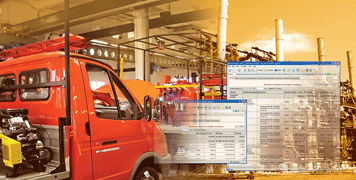Symbiosis of 1C:Enterprise and access control systems. A new look.
The intensive development of IT technologies for enterprise management and security technologies inevitably had to lead to their intersection. This process has been going on for a number of years and is actively discussed on the pages of various publications by both industrial automation specialists and security specialists. It is easy to predict that in the future a complete merger of these spheres is quite possible, but today we can only really talk about an effective and mutually beneficial symbiosis. In particular, there are specific areas of activity in which such a symbiosis is not only ripe and not only technically possible, but is already in demand and brings real benefits. Today we will talk about the symbiosis of «1C: Enterprise» and access control systems.
ACS for enterprises and the economic crisis (To automate or not to automate — that is the question)
Automation of production management processes initially pursued the goals of optimizing and increasing the efficiency of management, the enterprise's HR department, accounting and a number of other departments, in particular the security service. The economic crisis affected all areas of production, hit all companies and forced managers to think more carefully about reducing costs, as well as increasing the efficiency of all departments and all systems. To save the business in these conditions, it is necessary to re-evaluate the efficiency of all processes and each employee, and not just evaluate, but take measures to improve it. In this matter, the role of automated enterprise management systems, as well as the requirements for them, are increasing many times over. Both managers and employees understand that there is no way to hide and leave everything as it was, since this will lead to collapse. Even to preserve production, the team and the level of existing wages, new efforts, new solutions, new technologies are required. Simply put, now everyone must work for three, and one of the real ways to intensify the work of each employee is to automate his work processes.
What should be automated?
It is clear that theoretically it is possible and necessary to automate all processes and all work at the enterprise. It is even more clear that it is impossible to do this all at once and right now. The question arises: what should we pay attention to first? Where will automation bring the desired result quickly? These questions and all responsibility for their solution fall directly on the shoulders of the enterprise management, especially when there is no opportunity to hire paid automation professionals. Most often, and this is justified, the processes associated with the processing (registration, storage, analysis) of large volumes of information or data fall under automation. As a rule, these are departments that deal with accounting, tax, personnel records, are responsible for the movement of inventory items, etc. At the initial stage, there is a disjointed automation of various accounting and control tasks of various departments. As a result, several disparate information bases with intersecting information and manual duplicate data entry appear.
Patchwork automation
A standard patchwork automation approach can be considered using the example of organizing an access control system, maintaining personnel records, and recording the actual time worked by employees of an enterprise. At first glance, the above tasks are practically unrelated to each other and are the responsibility of different departments. The security service is responsible for ensuring the safety of the facility, access control, organizing the access control system, and monitoring the entry/exit of material assets; the HR department is responsible for personnel records and monitoring labor discipline; the functions of recording the actual time worked by employees of the enterprise and calculating wages based on it are assigned to the accounting department. Upon closer examination, intersections between tasks become visible; in particular, all departments use the same list of employees of the enterprise. Based on the data on employee work schedules and their affiliation with different departments provided by the HR department, the security service can organize the delimitation of access rights to different premises on the territory of the enterprise. Based on the data on employee movements provided by the security service, the accounting department can adjust the actual time worked by employees.The standard approach to initial automation is the organization of an access control and management system (ACMS) at the enterprise, which has its own software. Such software of various ACMS (Perko, Kronverk, Gate, Boli, Parsec, etc.) solves the problems of the security service. To automate the maintenance of personnel records and payroll, specialized accounting systems are installed, among which the most widespread in Russia and the countries of the former Soviet Union are software products of the 1C company, in particular, 1C: Salary and HR Management. The 1C and ACMS systems are not connected with each other in any way, data is transferred between departments in the form of separate files or even on paper. It is not surprising that the amount of duplicate manual input and processing of information, and therefore the likelihood of introducing errors, grows so much that it neutralizes the benefits of existing automation systems, hinders the development of the enterprise, and sometimes leads to direct losses.
Integration and complex automation
It is almost impossible to find a ready-made enterprise automation system that covers all information processes. Therefore, the choice of an information system is always a multiple compromise, in particular between the functionality of the system and its cost. It is more difficult to assess the optimality of the system's compliance with the specific tasks and conditions of a particular enterprise. The automation systems known on the market can be divided into two classes according to the degree of flexibility and adaptation: rigid — with a set of standard settings (mySAP Business Suite, Oracle E — Business Suite, «Galaktika») and flexible — with the ability to change their functions (1C, Microsoft Axapta). Moreover, the latter are more common in Russian reality. The most famous and widespread software package designed for production management is the 1C software package.
«1C: Enterprise»
The 1C software package is designed to manage an enterprise and allows you to receive reports on almost any parameters. For example, you can track the history of an employee's career, sick leave, business trips, etc. The built-in personnel accounting system facilitates the process of hiring, firing and job transfers of employees, maintaining a register of personal employee cards with a set of various information about them. In addition, the automation system allows you to identify violations in personnel processes, support decision-making on their normalization, streamline all accounting and settlement processes with personnel, reduce possible losses due to employee departure.
Access control and management systems (ACS)
One of the most popular blocks of «1C: Enterprise» is automation of operational personnel records and payroll calculation. In particular, it is for this segment that the data accumulated by the access control and management system are of particular importance. Modern ACS provide reliable and diverse data on the presence of an employee on the territory of the enterprise or its individual divisions. But, unfortunately, most of these systems cannot yet operate under the 1C software package or promptly interact with it. This is due to the evolution of the development of ACS from the security sphere, where it traditionally solved the problems of restricting and delimiting access, organizing controlled passage and travel to different zones and territory of the enterprise, etc. ACS data, as a rule, either did not get into the management accounting system at all, or were transferred manually. Less often, some methods of periodic and semi-automatic data transfer were developed and implemented. In this case, not only the efficiency of data receipt is lost, but also their diversity and volume.

Operation of ACS under the control of the 1C software package
Organizing the work of the ACS directly under the control of the 1C software package allows solving many of the above-mentioned tasks and problems, increasing the efficiency of the entire management system, reducing labor costs of a number of departments and the number of errors. What are the advantages of such integration? First of all, it is the creation of a single information space and a system for organizing the access control system, accounting for actual time worked, vehicle movement and movement of inventory based on the optimal use of the advantages of the ACS and management programs. Full integration with the accounting programs «1C: Enterprise 8» «Salary and HR Management» and «1C: Enterprise 8» «Manufacturing Enterprise Management» provides a solution directly from 1C applications for a number of tasks:
operational management of ACS controllers;
automation of the work of the pass office both in terms of its employees, and in terms of visitors, and in terms of vehicles;
automatic generation of timesheets with support for floating and shift work schedules;
centralized management of geographically distributed enterprise facilities, as well as organizing control over local business trips of employees and their visits to these departments;
automation of accounting for the entry/exit of material assets.
This approach increases efficiency and primarily affects the work of the accounting department, HR department and security service of the enterprise. What does the implementation of a single automated information system give for each of these services?
Security Service
Firstly, management of passes and employee access levels with the preservation of the history of pass transfer and change of access. Secondly, the ability to link the personal data of a client or employee with the moved inventory. In the interests of the security service, the system provides:
real-time event monitoring;
operational control of the location of visitors and employees;
control of entry/exit of vehicles;
photographing visitors with reference to scanned documents when issuing passes;
photo verification of employees and visitors when passing through checkpoints;
the ability to obtain integrated information about a visitor/employee: personal data, number and characteristics of a vehicle and characteristics of received inventory items.
Accounting
For the accounting department, the implementation of a unified system allows:
automate the generation of timesheets and payroll calculations based on the data of the passes;
generate timesheets for several calculation strategies, as well as taking into account changes in the employee's work schedule during the reporting period, taking into account business trips and sick leaves;
keep track of overtime, taking into account evening and night hours;
generate a single timesheet in the presence of geographically distributed facilities.
Human Resources
For the human resources department, the use of a unified information system allows:
to effectively monitor labor discipline; to analyze employee tardiness and early departures for an arbitrary period of time;
to organize the prompt issuance/withdrawal of visitor/employee passes, changing work modes and access levels;
to analyze overtime;
to monitor employee time off and local business trips.
Such an integrated solution is a logical, evolutionary stage in the development of enterprise automated control systems and security systems. It takes the enterprise to the next level of production automation, allows saving wage funds, implements effective control over employee activities, and helps ensure the safety of material assets. Similar solutions are already available on the market and will certainly become a standard norm in the future.
